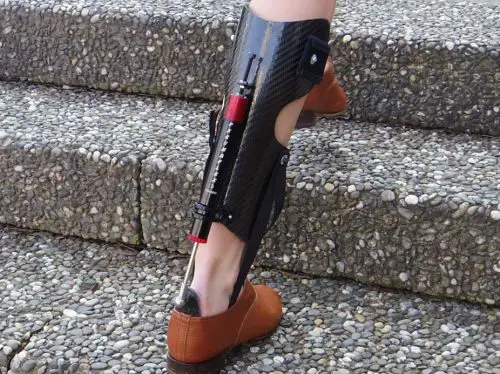La sciatica is a fairly frequent reason for consultation in current practice. Sometimes, however, this condition becomes more complicated and presents itself in a particular and severe form, which is called crippling sciatica.
How is crippling sciatica defined? What is its particularity? How to recognize and treat it? Answers in this article.
Lumbar Spine Anatomy
La lumbar spine is the lower part of the spine, it follows the dorsal spine and precedes the sacro-coccygeal spine and articulates with the sacrum.
It is made up of five vertebrae linked together by intervertebral discs which are formed of two parts: the central part called " pulpy nucleus » and the peripheral part, surrounding the latter, called « fibrous ring ».
Le Lumbar spine presents a spinal canal containing the nerve structures, more precisely, the lower part of the spinal cord which ends at the level of the L2 vertebra where nerve roots exit through orifices called “ foramina ».
Among the nerves leaving the vertebral column, we can cite the sciatic nerve which provides sensory innervation and part of the movements of the lower limb.
Le sciatic nerve has two main roots which are: the L5 root, coming out between the L4-L5 vertebrae and the S1 root which comes out between the L5-S1 vertebrae
Finally, the lumbar spine has a natural curvature called " lumbar lordosis ».
What is sciatica?
La sciatica defines pain occurring along the course of one or both roots of the sciatic nerve, it is usually due to compression of the latter.
Le sciatic nerve represents the largest and longest nerve in the human body, so it can cause severe pain, sometimes even resistant to analgesics.
According to compressed nerve root, the path of the pain may differ, we will distinguish as follows:
Localized pain behind the thigh, on the outer part of the knee and leg, on the top of the foot and ending at the level of the big toe, when the L5 root is compressed.
On the other hand, when the compression concerns the S1 root, the path of the pain is located behind the thigh and the knee, at the level of the calf, the heel, the sole of the foot, to end at the outer edge of the foot up to the last three toes.
In general, only one lower limb is affected by sciatica, however it sometimes affects both legs.
To know everything about the lumbosciatica, see the following article: https://www.lombafit.com/sciatique-a-z/
Paralyzing sciatica, what's special?
The sciatic pain are caused by pathologies affecting the spine, such as herniated disc, spinal osteoarthritis or narrowing of the lumbar canal.
When the pain is also felt in the lower back, it is called lumbosciatica.
Sometimes sciatica is accompanied by a motor deficit of the leg or even paralysis flaccid of the levator muscles of the foot, it then becomes a crippling sciatica.
This paralyzed sciaticahealth is the cause of a loss motor control of the levator muscles of the foot. It can also affect the lateral peroneal fibular muscles which are responsible for controlling the lateral movements of the foot (anti-sprain control): the paralyzed foot then falls while looking towards the ground and is no longer able to maintain itself out of voluntary and attentive control.
Paralyzing sciatica is a real neurosurgical emergency and it unfortunately happens to see, in spite of a well carried out surgical intervention, the motor deficit persist and even worsen.
How to make the diagnosis of crippling sciatica?
Paralytic sciatica is clinically defined by a motor deficit frank, that is to say less than or equal to 3 in muscular testing, of sudden or progressive installation.
In nearly three out of four cases, the deficit concerns the L5 territory. However, it is possible to find it in the S1 territory.
The clinical signs found are generally:
- A paresis of the extensor proper of the big toe during L5 sciatica: this deficit is not specific to paralyzing sciatica, because it is found in almost every examination of common L5 lumbosciatica. Recovery from this motor deficit is very frequent despite its more or less slow delay.
- Un motor deficit concerning all the muscles of the L5 territory, namely: the extensors of the toes, the lateral peroneal muscles and sometimes the gluteus medius. Or more rarely the S1 territory by affecting the triceps surae, the flexors of the toes and to a lesser degree the hamstrings.
In this case, it is truly paralyzing sciatica requiring urgent surgery to remove the obstacle, especially if the deficit is equal to or less than 3. Motor recovery is unfortunately not constant, and it It is even possible to observe an aggravation in certain situations.
- The sudden appearance of a massive neurological deficit (0 on testing) occurring after a hyperalgesic phase: this is sciatica paralyzing with apoplectic onset, when it is accompanied by a disappearance of sciatic pain, the need for surgery becomes questionable because it does not seem to bring any benefit in terms of the recovery of the deficit, which is unfortunately already very compromised.
Confirmation of the diagnosis requires the urgent performance of certain imaging examinations, namely:
- A lumbosacral computed tomography (CT):
It confirms the presence of a herniated disc and eliminates other causes of compression such as a tumor.
- Lumbosacral magnetic resonance imaging (MRI):
Lumbosacral MRI can confirm the existence of root compression and determine the cause (usually a herniated disc), as it can help rule out other diagnoses (differential diagnoses).
- An electromyogram (EMG):
This examination can, in rare cases, make it possible to make the differential diagnosis with a lesion of the external popliteal sciatica.
Things to do
Paralyzing sciatica is a real neurosurgical emergency.
Indeed, it is part of hyperalgesic sciatica and cauda equina syndrome of the only absolute surgical indications for root compression to be operated within twenty-four hours.
The isurgical intervention consists of a partial or complete removal of the intervertebral disc, in order to release the compressed nerve root and allow its relief. Associated with a laminectomies to increase the diameter of the spinal canal.
It is important to note that in the case of paralyzing sciatica, even emergency surgical treatment sometimes does not allow the deficit to be recovered. It even happens in certain situations to see aggravations appear post-operatively.
Finally, it is important to specify that prevention of paralyzing sciatica is possible thanks to good management of common sciatica, in particular by practicing non-traumatic sports allowing the back and stomach to be muscled, the loss of weight in case of overweight, respect for a healthy lifestyle (avoid sudden movements and maneuvers, optimize sleep, reduce stress, etc.).
Resources
My name is Sidali. I am a general practitioner and Web Editor. As a healthcare professional, my mission is to contribute to the relief of my patients' ailments. Being also passionate about writing, I have the pleasure of sharing my solid medical knowledge with the greatest number of readers, by writing popular articles that are very pleasant to read.


